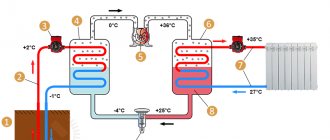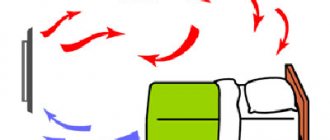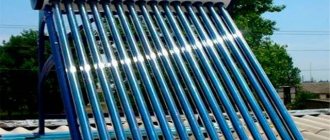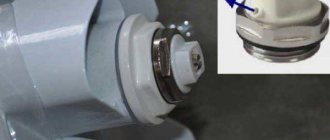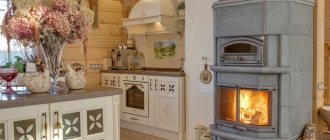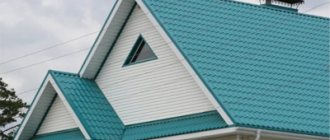A modern home needs a high-quality ventilation system. It's a matter of health and wellness—everyone wants to breathe clean, fresh, pathogen-free air. It turned out that the house was built in a small village quite far from the city and its main communications. Moreover, in Russian conditions, housing also needs to be heated for a significant part of the year.
So, we built a frame house with an area of 200 square meters with a well-designed ventilation system, and only electricity as a heat source. The choice of heating system seemed obvious - we decided to go with an air-to-air heat pump, compatible with ventilation.
Why not firewood?
Our neighbors mostly heat wood stoves, but initially we didn’t like this option. Every year you need to stock up on fuel, clean the boiler, and monitor its combustion. With electricity, everything is much simpler - I pressed the switch, the heat came. The only disadvantage of this method is the high cost of electricity. At the time the heating system was launched, a kilowatt-hour in the Moscow region cost 5.29 rubles.
Naturally, we wanted to use such a valuable resource as economically as possible, so we settled on an air-to-air heat pump. This is the cheapest option and works almost like an air conditioner.
Advantages and disadvantages
A heat pump is a technically complex system that has its pros and cons. Before purchasing an air-to-air system, familiarize yourself with all the nuances so that you understand what you need to prepare for in advance.
Advantages:
- The system is universal and suitable for heating houses of any size, and can also be used in cooling mode and partially replace an air conditioner;
- The heat pump is environmentally friendly and does not pollute the environment with combustion products. In the CIS countries, few understand the scale of the problem, but in Europe every homeowner is trying to combat global warming;
- The system is easy and quick to install. You can entrust the installation to a regular company that installs air conditioners;
- Heat pumps are fireproof, unlike stoves, fireplaces and boilers that run on combustible or solid fuels;
- The system is very economical and will allow you to significantly save on electricity when heating even a large house. This is especially true if there is no gas in your locality and is not expected;
- Heat pumps are reliable. The only technically difficult part is the compressor. It needs to be maintained regularly, but this is not a difficult or inexpensive task. In addition, compressors rarely fail if they are regularly monitored;
- The heat pump operates automatically. You only need to initially set the operating mode. Even a child can cope with this task.
Flaws:
- Noise. It is insignificant, but at night it can interfere with particularly sensitive household members;
- Increased amount of dust in the air due to constant convection. Frequent wet cleaning helps;
- Uninterrupted power supply is required. The generator partially copes with the problem;
- High cost for initial installation;
- Suitable for air heating only. For water you will need a separate device;
- Low efficiency when used in frosts below -10 degrees Celsius.
Read more about working in cold weather
It’s no wonder that heat pumps are so popular in central Europe, where frosts are traditionally not as severe as in Siberia or other cold regions of Russia. After all, one of the key disadvantages of such a system is ineffective operation at temperatures below -10 degrees Celsius. The colder it is, the more electricity is needed for the heat pump to function properly. In this case, all the efficiency of this system is lost.
If you plan to use a heat pump in a very cold area, look for a different heating system or use the pump in conjunction with a stove/fireplace.
If your house is built of wood or SIP panels and frosts below -10 degrees last no more than one or two weeks, you can get by with just a heat pump. In all other cases, it is definitely not enough to effectively heat the premises.
Equipment operating parameters
Severe frosts in the Moscow region are rare; experience has shown that the temperature rarely drops below -25℃. We calculated that in such conditions, a pump producing 15 kW of heat would be sufficient for a house with the available space. The system budget cost us approximately 150,000 rubles.
The efficiency of air pumps also varies depending on external conditions. In our case, it turned out that when consuming 1 kilowatt-hour of electricity, the system produced 2-2.5 kW of heat. It's minimum. If there is a slight thaw outside with a temperature just above zero, then it produces 3.5 kW of heat.
The house is heated evenly by warm air; there are no radiators or heated floors. Fresh street air is constantly added to the system through a recuperator.
The purpose of the recuperator is to further save heat. With its help, the air coming from the street is heated by the air that is forcibly emitted from the house, for example, from the bathrooms. The desired room temperature is set on the remote control.
The control is automatic; at night the temperature is reduced for greater comfort.
Reviews from real owners from Russia
Ignat Gavrilyuk, Ekaterinburg
I live in the Krasnodar Territory, I have a house of 150 sq. m. m. For two years they heated with electricity, the average consumption per season was 3.8 kW/hour. This includes the refrigerator, washing machine and other household appliances. Then, on the advice of friends, they installed an air-to-air heat pump (I would like a geothermal one, but money is tight).
As a result, consumption dropped to 2.7 kW/hour. Then I calculated exactly how much we spent on heating - it turned out that heating with convectors is one and a half times more expensive than using a heat pump. It turned out that in 4-5 years it will pay off, and then there will be net benefit.
Ekaterina Evgenievna, Novosibirsk, Russia
We thought for a long time about how to heat the house - electricity is unprofitable, gas is expensive, and wood or pellets are inconvenient. After rummaging around on the Internet, my husband and I decided to buy an air-to-air heat pump.
There were no problems with the installation, it warmed up perfectly in the fall, and when the cold weather set in, it stopped coping. As a result, we had to install convectors. After two seasons, my husband summed up the results: there is a benefit, but given the cost of the heat pump and convectors, they will pay for themselves in 10 years.
Nikolay A. Krasnoyarsk
I read a lot of squabbles on the forums, and decided to leave my review about the air-to-air heat pump. I am the owner of a house of 240 square meters, I have been using two 12 kW inverter units for 4 years.
In the first season, during severe frosts, the temperature dropped to +18, but the façade was insulated and the problem disappeared. Then there were only advantages - the main thing is to leave them on if you leave home for a long time.
Regarding payback, that’s a separate conversation. Everyone only considers the heating season, but in the summer there are costs for operating air conditioners. An air source heat pump has a higher efficiency and requires less electricity to cool the house.
Over the past year, I summarized the statistics - the ratio of savings in winter and summer is approximately 1 to 3. It turns out that to calculate real savings, take the indicators for the heating season and multiply by 1.33. That's math!
Almost all modern models of air-to-air heat pumps can operate for both heating and cooling.
Gleb Akhverdov, Moscow
There is a small service station with 2 lifts. The ceilings are high, there is no point in warming up the room and insulating it - people don’t live in it. We thought about installing simple air conditioners, but on the Internet I came across an analogue - air heat pumps.
The only problem is that there are drafts in the room and the box is often open. Now, if only it was insulated and the gates were locked... It’s difficult to warm up the room itself, but they installed fan coil units to blow air into the place where the guys work.
We installed two 10 kW units, one for each lift. The craftsmen couldn’t be happier, but I decided to do the calculations; for the season it turned out to be something like 7500-8000 kW. In addition, power tools still work, so the figure is actually lower. I looked at how much it would cost for infrared heaters and convectors - the savings are one and a half to two times. With large consumption, a serious amount results.
A. Alekseev, Moscow region
There is a small house, made of aerated concrete, well insulated, with an area of 140 meters. An air source heat pump is enough. At first I had to fork out money, but in the end it paid for itself in 3 years.
I don’t think that everyone will have such a payback period - my house is thoroughly insulated, and aerated concrete blocks retain heat well. Plus 3-chamber double-glazed windows.
Nikolay Alexandrovich, Sverdlovsk region
Friends recommended a ground-to-water heat pump, but drilling wells is expensive here - the soil is rocky, and there is not enough space to lay horizontal pipes. I had to settle on an air source heat pump (I heat the water in the kitchen and bathroom with a boiler).
I found an acceptable option for 16 kW of thermal power (house of 200 square meters). The company delivered and then disappeared in an unknown direction. When winter came, it turned out that only a third of the house could be heated properly.
When I called the normal craftsmen, they said that they sold me a Chinese unit that was dying and did not produce normal power. So be careful when choosing a supplier!
This is what the indoor unit of an air-to-air heat pump looks like.
Heat distribution across rooms
Each room needs its own amount of heat. For example, corner rooms always require more of it, because they have two cold walls. We solved the distribution problem using valves.
In other places, the supply is regulated by valves on the grates. They stand not only in the ceiling, but also in the floor. This is very important for uniform heating and comfort - everyone knows that warm air rises. The air intake for exhaust from the premises is arranged in a similar way - it is produced both from the ceiling and from the floor.
It has already been mentioned how air is removed from the bathrooms: to the street through a recuperator, so odors do not spread throughout the house.
Installation Features
First of all, it is worth noting that the installation of such systems requires certain qualifications of craftsmen and it is better that it is carried out by professionals. The heat pump diagram of an air-to-air system assumes the presence of two blocks, external and internal. The entire structure is quite lightweight, which allows the external block to be installed even on top of roofing material, such as tiles.
When placing the indoor unit, you must be guided by the principle of maximum efficiency of heated air circulation throughout the room. Its installation can be done both on the wall and on the ceiling.
The use of air heating as the main source of heating the room involves the creation of a complex branched system of air ducts
The length and location of air ducts must be carefully calculated by specialist installers. The optimal solution to disguise them would be to install suspended ceilings.
External part
The outdoor heat pump unit sits behind air-transparent blinds. It is quite large and looks like an industrial air conditioner. In winter, the pump housing freezes and becomes covered with a thick coat of snow. This is a process provided for in its operation - according to its internal algorithms, the equipment regularly goes to defrost and completely thaws. After this everything repeats itself.
Operating principle
The operating principle of an air-to-air heat pump is based on the same physical phenomenon that underlies the functioning of refrigeration equipment. Only in this case it is applied in reverse. The refrigerator removes heat from the space inside its body, and you can notice that the radiator grille located outside it heats up.
The sequence of actions of an air-to-air heat pump is as follows:
- A fan driven by an electric motor draws outside air into the unit housing. It enters the heat exchange system, where, upon contact with the tubes through which the refrigerant flows, it releases thermal energy. As a result, the refrigerant changes its state of aggregation from liquid to gaseous.
- At the next stage, the resulting gas enters the compressor, where it is compressed, which is accompanied by even greater heating.
- After this, in the condenser already located in the heated room, a reverse transition of gas into liquid occurs with the release of thermal energy, which is used to heat the room.
- At the final stage, liquid freon is again sent to the external heat exchange system, and the previously built-up pressure is released through a special valve.
All these operations are repeated cyclically.
The temperature of the refrigerant, as a rule, is always lower than the ambient temperature and it always receives thermal energy from the street. However, in severe frosts, the efficiency of this heating method will be quite low.
Conclusions based on the results of use
The entire turnkey ventilation and heating system cost about 280,000 rubles. Here we must take into account that the work was carried out on our own, and when purchasing equipment and materials, the talents of “knocking out” discounts were used to the maximum.
Many do not believe that in our latitudes it is possible to heat ourselves with air heated by electricity. From our own experience we can say that this is real. Such systems work and even allow you to save money. Our average monthly heating bill is 6,000-8,000 rubles. From the experience of neighbors with houses of similar size, we know that they pay both 20,000 and 25,000 rubles per month. It turns out that all our costs for installing an air-to-air heat pump will be fully recouped in about 2 years.
Update 2018: Reviews on the operation of air source heat pumps
Alexey Vuk
I live in a harsh region where winters are long and cold, and there is no gas. They advised me to buy an air source heat pump so as not to heat with wood. The “specialists” from the company said that it would be cheaper and more convenient. And I, a fool, listened to them.
I bought a middle-class Chinese air-to-air heat pump, they installed it and connected it to me. At the beginning of autumn everything was fine, but when the cold weather hit... In general, after -10 it barely warmed up, and the electricity was overwhelming. I thought maybe something was broken there. I contacted the company that sold it to me and supplied it...
There I was gently sent far, far away. It turned out to be my fault, as I did not read the documents for the unit. And it says that this air heat pump works effectively at above-zero temperatures. In short, I wasted my money in vain. Well, at least you can warm up in autumn and spring, but in winter you’ll have to do it the old fashioned way.
Marina, Nizhny Novgorod
In the fall, my husband bought and installed a Cooper Hunter air source heat pump. At first I thought that it would be easier to heat the house with air conditioning, but then I realized that I was wrong. My friends’ splits were not heated at sub-zero temperatures, but ours, a Stakhanovite, threshed. And in the spring we calculated the cost of electricity.
It turned out that the Cooper Hunter will pay for itself in 7-8 years. But in the summer it also works, cooling the house. If you subtract the price of the air conditioner, the savings are even greater. In general, I'm satisfied.
What equipment is used for air conditioning
The following types of split systems for industrial use are in wide demand:
- wall-mounted - the most common type of air conditioning systems. Consist of an external and internal block. Mounted on the wall of a refrigerated room.
- cassette - installed on a suspended ceiling. In terms of external design, they are similar to the chiller-fan coil system, but differ in the parameters of the coolant. In air conditioners, freon plays its role. Chiller fan coils contain water or glycol solution.
- Ducted ones are a great way to cool the air in large rooms. Does not disturb the external and internal aesthetics of the building (air ducts are hidden in the ceiling or walls). There is a drawback: highways are designed at the construction stage.
- floor-ceiling systems are installed in buildings where installation of traditional wall systems is not possible. Powerful and large-sized devices are capable of quickly and efficiently cooling large rooms. They can be seen in large fitness centers and clothing stores.
- multi-split systems - in this case, several indoor units are connected to one outdoor unit. Each of the devices can be controlled individually, adjusting the temperature according to the needs of the people in a particular room.
- multizone systems, VRV, VRF . Traditional split systems are limited by the length of the freon line. Usually it does not exceed 25 meters. This is exactly the problem that multi-zone systems, VRV and VRF solve. As in multi-split systems, several indoor units can be connected to one outdoor unit, but in VRV their number can reach several dozen. VRV indoor units can be of different types (wall-mounted, duct-mounted, cassette) and have different capacities.
- “chiller-fan coil” system is an air conditioning unit in which the working substance is a cooled liquid. The nature of the coolant is the main difference between this installation and traditional air conditioners that use freon. The coolant in the chiller-fan coil system does not have the limitations characteristic of freon.
- The compressor-condensing unit (CCU) is an important element of the air cooling system. It is here that the liquid refrigerant is prepared for further evaporation in the heat exchanger. Most often, KKB is used in conjunction with ventilation units or internal units of split systems of various configurations.
- Precision air conditioners allow you to maintain air parameters with very high accuracy. Electronic devices are very sensitive to both too high and too low temperatures.
- Central air conditioners are designed primarily for large spaces. This type of air conditioning is used in both residential and commercial buildings (hotels, concert halls, halls). A central air conditioner is a non-autonomous device: to operate, it requires an external source of cold or water from a chiller, freon from an external compressor-condensing unit, hot water from a central heating system or boiler. Allows you to organize efficient cooling or heating of a large building without the need to place outdoor units on the facade.
- Roof tops, or roof air conditioners, are monoblock climate control equipment for installation on the roof. Typically, this type of installation is used for air conditioning and ventilation of large commercial, industrial and sports facilities. In addition to standard components (compressor, condenser, evaporator and fans), the rooftop can contain a mixing chamber in which exhaust and outside air are mixed.
There are various segments of equipment on the market, the cost of sales of which may differ by an order of magnitude. When choosing suitable climate control equipment, you should take into account the resource (power), the volume of the room covered, the availability of additional options and the budget.
Air conditioning in the apartment
The following types of climate systems are in demand for domestic use:
- wall split systems. Due to their small size, these models take up little space and effectively cool the room. The units are very easy to use, ergonomic and fit well into the interior of the room;
- multi-split systems - this type of air conditioning is recommended when there is not enough space to install several outdoor units and there is a need to cool more than one room. In this case, several indoor units are connected to one outdoor unit. Multi-split air conditioners allow you to connect several (up to 5) indoor units to one outdoor unit. In each of the rooms equipped with an internal module, it is possible to individually regulate the air temperature;
- duct air coolers - these devices are in demand when a ventilation system is implemented. The devices are built into air ducts, cool the fresh air flows to specified values, after which the air masses enter the room through the supply channels.
It is worth noting that the electricity consumption of air conditioning equipment is relatively small, but can increase significantly with prolonged use. When choosing, pay attention to the energy class of the device. Those with the highest class "A" produce about 3.2 kW of cooling power from 1 kW of electricity consumed. Appliances with energy class "D" will only produce about 2.6 kW of cooling power at 1 kW.
How to choose an air-to-air heat pump
The market offers several types of TN. Moreover, each of the models has a certain set of characteristics that affect the possibilities of application. When selecting equipment, you need to pay attention to the following parameters:
- Heat pump performance.
- Manufacturer company.
- The price of both the equipment itself and its installation.
The presence of additional functions matters. For example, some models can not only heat, but also cool the air. In cold regions, it is preferable to use devices with built-in electric or water heaters.
Simply put, the characteristics of the equipment must match the operational parameters of the building in which the installation will be performed. Therefore, when choosing a pump, it is necessary to consult with professionals.
What happens if the electricity goes out?
In the event of a power outage, your home heat pump will eventually stop working... like any other modern heating gas, diesel or pellet boiler, which cannot operate without power from the control automation. The solution here is quite simple - an autonomous gasoline or diesel generator. At a cost of 200-300 dollars, this solution is the most optimal. h2 Emergency situations and breakdowns.
Any, even the most reliable equipment, can fail; no one is immune from this. What is really important is the time it takes for the service department to respond and fix the breakdown. Specialists of Nova Gros LLC travel to any point in Belarus within 24 hours, all main components and spare parts are stored in our warehouse.
Also, all HP produced by Stiebel Eltron have a built-in backup electric heater installed. It allows you to maintain an acceptable temperature in the building in case of compressor failure, freon leakage, damage to the external collector and other breakdowns.
Nova Gros LLC - Official service and warranty center of Stiebel Eltron
Connect with us
Connect with us
